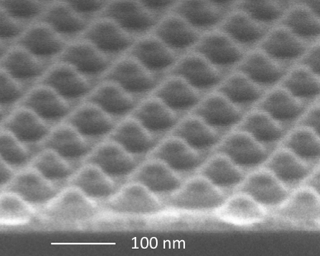Jan 8 2015
Computers are basically machines that process information in the form of electronic zeros and ones. But two MIT professors of materials science and engineering are trying to change that.
 Magnetic tunnel junctions hidden under cones of tungsten used as an etch mask. The tunnel junctions were made from a film deposited by Weigang Wang’s group at the University of Arizona, and patterned using self-assembled block copolymer lithography in Professor Caroline Ross’ group. Image courtesy of Caroline Ross.
Magnetic tunnel junctions hidden under cones of tungsten used as an etch mask. The tunnel junctions were made from a film deposited by Weigang Wang’s group at the University of Arizona, and patterned using self-assembled block copolymer lithography in Professor Caroline Ross’ group. Image courtesy of Caroline Ross.
Caroline Ross and Geoffrey Beach are members of the Center for Spintronic Materials, Interfaces, and Novel Architectures (C-SPIN), a University of Minnesota-led team of 32 professors (and over 100 graduate students and postdocs) from 18 universities trying to restructure computers from the bottom up. C-SPIN researchers want to use the “spin” of electrons on nanomagnets — rather than electric charge — to encode zeros and ones. If they are successful, the computers of 2025 could be 10 times faster than today’s computers, while using only 1 percent of their energy.
Before C-SPIN began in 2013, spintronics research was carried out in many corners of American academia. The center, which is funded by a consortium of defense and industry sponsors, has helped researchers like Ross and Beach work directly on specified projects with colleagues around the country. “I appreciate the diverse group of students, faculty, and industrial researchers that C-SPIN brings together,” says Ross. “I’m part of a work flow that includes researchers from Arizona, California-Riverside, Johns Hopkins, Carnegie Mellon, Minnesota, and Penn State. With the Center’s coordinated funding, we are making significant progress.”
Ross, the Toyota Professor of Materials Science and Engineering and associate head of the Department of Materials Science and Engineering, is developing methods to pattern ultra-small magnetic structures, and she is also working on magnetic “insulators” that help control the way “spin” is shared with neighboring magnets and other devices. One such magnetic structure is pictured at right.
Beach, the Class of '58 Associate Professor of Materials Science and Engineering, is investigating ways to reduce the power required to “switch” magnetic spin — that is, to make an “up” magnet “down,” and vice versa. This process basically translates into changing zeros to ones and ones to zeros, something computers do billions of times per second. He recently discovered a new way to perform low-energy spin-switching (published in the prestigious Nature Materials and reported on here at MIT) which has led fellow C-SPIN researchers to develop new theoretical and experimental spin devices.
Spin-based computers aren’t on the near horizon, notes Beach, but C-SPIN researchers have moved much closer to that goal over the past two years. “Hybrids are also a possibility,” says Beach. “It’s not hard to imagine a computer in 2025 with spin-based RAM and some spin-based processing.” Given what the center has accomplished in the past two years, the computing world could be much different by the time Ross, Beach, and their colleagues are done.